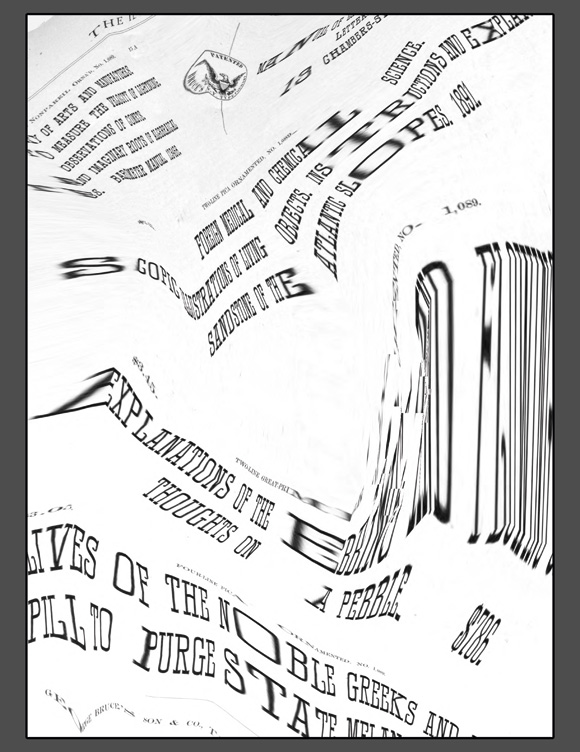Andrew Norman Wilson with Laurel Ptak: ScanOps
Andrew Norman Wilson’s ScanOps project examines the systems, people, and processes behind Google Books. Here he speaks with curator Laurel Ptak about the project.
Laurel Ptak: Tell us about your recent photographic series ScanOps. How did the project develop?
Andrew Norman Wilson: I have been collecting “anomalies” from Google Books for a couple of years: images in which software distortions, the imaging site, or the hands of the Google employees doing the scanning are visible. The fingers and software distortions obscure the information in the books—which complicates the notion of universally accessible knowledge.

Andrew Norman Wilson, The Inland Printer-164, 2012
LP: Where does the title ScanOps come from?
ANW: It’s the departmental name for Google’s onsite book-scanning operations at their headquarters in Mountain View, California. I’m pretty sure the name “ScanOps” was never public—I found it searching around Google’s Intranet.
In 2011 I made a video called Workers Leaving the Googleplex. I worked for a year in 2007–8 on Google’s campus. While there, I wore a red badge—like most other contracted employees. The fulltime Google employees wore white badges, and interns wore green badges. In the video, these “classes” of employees are seen passing by, entering and exiting buildings at the Googleplex. Some of them ride Google loaner bikes; some are seen getting into a Google limo shuttle headed toward San Francisco. Some of them are leaving work, some may be walking to another building to exercise in one of the Google gyms or pick up their laundry, some may be just arriving at the Google campus to eat a free meal from one of the twenty gourmet cafés after a day of working at home.
But from my office, I noticed a fourth class of workers operating in the building next to where I worked; they wore yellow badges. They stood out on the Google campus because of their races—many are people of color—and their attire, which was not that of the usual tech worker. In the Workers Leaving video, the yellow-badge employees are seen leaving the one building they are allowed access to. They all leave at the same time every day—2:15 pm—because their superiors have asked them to. It is a separate departure time from the other workers, so their exit is its own “movement.”
LP: Can you talk about the films by the Lumière brothers and Harun Farocki that influenced you in putting your film together?
ANW: In Farocki’s 1995 film Workers Leaving the Factory, he discusses how in the Lumière brothers’ film, also called Workers Leaving the Factory (1895), the primary aim was to represent motion; in particular to create an image of a work force in motion, organized by the work structure (a temporal construct), the factory gates (a spatial grouping), and the filmmakers’ choreography of this time-space relationship. But of course moving images don’t only represent movement, they can also grasp for concepts. This is what Farocki’s film is about—how signs and symbols are taken from reality, as if “the world itself wanted to tell us something.” He uses a particular motif in film history—that of workers leaving the factory—to interpret what the world is telling us.
The Lumières’ Workers and my own each present the social and technological conditions of their time. Both represent movement—but in my representation of movement, we see clearly defined tiers of workers … so the movement is “scripted” by what class they are in.
LP: ScanOps continues to follow these Google Books workers in another way.
ANW: While I was working as a video editor and videographer at Google, I started to document and talk to the ScanOps employees—but was fired rather quickly. It was intended to be a larger project, but it ended up being quite simple and limited because I wasn’t left with much more than my footage and my account of what happened.
At some point later I heard about the scanning mistakes and accidents that occur in Google’s book-scanning operations and decided to look closer. The work of the ScanOps employees is an interesting hybrid—it is a labor of digitizing informational materials that requires no cognitive involvement with the content of those materials. The labor process is quite Fordist—press button, turn page, repeat.
The workers compose part of the photographic apparatus, which in a broad sense includes not only the machinery but the social systems in which photography operates. The anonymous workers, Google founders Sergey Brin and Larry Page, the pink “finger condoms,” infrared cameras, the auto-correction software, the capital required to fund the project, the ink on my rag-paper prints, me—we’re all part of it.
LP: Would you discuss the thinking process behind your photographic work?
ANW: Each stop along the way in my work involves machines and humans. I like the idea that my work is part of a living, expanding process, and I am trying to underscore the fact that we are all complicit in and responsible for our social and technological arrangements. I want to dispel any notion that we are passively, subjectively impacted by foreign objects and systems.
LP: Take us through the steps in your work’s production, the logic of each decision in ScanOps.
ANW: Production starts before I get involved. The books are photographed at the libraries where they are stored, or are shipped to the Google Books facilities to be photographed. Software auto-corrects and converts the images and uploads them online. I browse for images that fulfill my criteria, download them, convert the pages I want, and edit out the Google watermark. There’s no resizing or additional editing.
Next I have them inkjet printed to scale, they are mounted and sent to the framers, who make a custom frame for each print. Then I bring the prints to Home Depot, and pick a color from each print for them to match. They mix up the paint in that color and I bring everything to an autobody shop, where the frames are sprayed in their respective colors. It’s a whole production line.
I’m choosing materials and production processes—some of them subcontracted to other people—that allow the materiality of the work to be emphasized. There are also preexisting conditions that communicate that for me, and I let them alone—for instance, leaving the images at their original size keeps them in direct correlation to the printed matter they came from. In a gallery or on the page of a magazine each work occupies a unique volume of space, and so when put together their spatial/sculptural qualities are emphasized.
LP: It’s compelling to think of ScanOps as a kind of update to the tradition of documentary photography, but for the online image.

Andrew Norman Wilson, The Inland Printer-152, 2012
ANW: I do look toward the work of certain documentary photographers—Dorothea Lange, Jacob Riis, Lewis Hine, and so on—whose socially engaged, journalistic photography represents marginalized populations, and in particular their labor.
In addition to the work engaging photography’s materiality and an interest in the abstraction that the anomalies can present, I like to think of each image—whether it contains accidents or not—as a view of the world. They reveal traces of the humans and technology that produced them.
LP: We most often encounter digital recordings of books as scans, but you refer to these as “photographs”—why is that? Who are the photographers here?
ANW: Mass-market books can be sliced open and fed into scanners, but the books I’m looking at come from library collections and can’t be dismantled; they need to be photographed with a camera from above. The fingers we see in some of the images could mistakenly be called the photographers’ hands—but their actions have been dictated by superiors at Google, so really they are the camera operators. The photographers are Sergey Brin and Larry Page, who proposed the digitization of all the world’s books when Google was just a fledgling startup. Because the copying of an entire book violates copyright, the photographers have been faced with lawsuits from the Authors’ Guild, the Association of American Publishers, and more.
Google is in the sole possession of the means of search and distribution for most of the books published in the United States in the twentieth century. For the first time, elements of public library collections are offered for sale through a private contractor, with additional revenue coming in from the ad space for sale next to the online books.
Everyone who uses Gmail, Google Docs, Google Books, Blogger, YouTube, etc. becomes a knowledge worker for the company. We’re all performing freelance data entry. Where knowledge is perceived as a public good, Google gathers its income from the exchange of information and knowledge, creating additional value in this process. Google, as we know it and use it, is a factory.
—
Top image: Andrew Norman Wilson, The Rainbow Girl-9, 2012 (detail)
Andrew Norman Wilson lives and works in Brooklyn, New York. He is currently working on a ScanOps book to be published by Art Metropole, and lecturing on ScanOps and Workers Leaving the Googleplex in his Powerpoint performance Movement Materials and What We Can Do.
Laurel Ptak is a New York–based curator. With artist Marysia Lewandowska, she is currently co-editing a book titled Undoing Property, examining relationships among artistic practice, intellectual property, immaterial production, and political economy, to be published this year by Sternberg Press.























